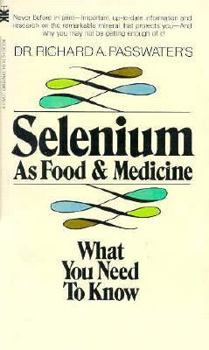Selenium as Food and Medicine
Select Format
Select Condition 
Book Overview
When a city in Connecticut passes a law that requires men to carry women across thresholds at all times, the town's citizens grapple with the practical and theoretical implications of the seemingly... This description may be from another edition of this product.
Format:Paperback
Language:English
ISBN:0879832290
ISBN13:9780879832292
Release Date:January 1980
Publisher:Keats Publishing
Length:240 Pages
Weight:0.55 lbs.
Dimensions:0.7" x 4.2" x 6.9"
Customer Reviews
1 rating
Selenium's vital role in the immune system
Published by Thriftbooks.com User , 15 years ago
Selenium's relationship with human health is beyond dispute. The trace element is a component of glutathione peroxidase, one of the body's three powerful enzyme protectors. Selenium has a special synergistic relationship with the anti-oxidants Vitamin E & the sulphur-containing amino acids. This 1980 book reports on population studies, clinical trials and laboratory experiments that have proved selenium's pivotal role in disease prevention and nutritional healing. Every chapter concludes with a short summary and a list of bibliographic references. The text is enhanced by figures, illustrations, tables and maps of the USA. There are chapters on how this mineral anti-oxidant protects the body against cancer, heart disease, arthritis, cystic fibrosis, muscular dystrophy and radiation. Selenium has anti-aging and immune boosting effects. It furthermore detoxifies pollutants, including the heavy metals cadmium, lead & mercury. A proven correspondence exists between selenium levels in the soil and the incidence of certain diseases. Researchers Drs Gerhard Schrauzer, Raymond Shamberger, Klaus Schwartz and Doug Frost provide brief overviews of their work and thoughts on the role of selenium. The best food sources are whole wheat grains, organ meats and fish. Helpful tables provide the relative selenium levels of a wide variety of foodstuffs -- no definite data can be established since soil concentrations of selenium vary so widely. The author calls for supplementation and provides recommended daily allowances. Supplementation and safety are discussed in two subsequent chapters. Passwater recommends a daily intake of at least 50 to 200 micrograms plus a diet rich in foods containing the element. Nowadays almost all multivitamin & mineral supplements contain selenium. There are three appendices: the free radical theory, the protein missynthesis theory and McCarthy's hypothesis on macrophage function. These are followed by a glossary of terms and an extensive index which concludes the book. Although published almost 30 years ago, this work is still relevant and valuable as an information & reference source on this vital anti-oxidant.





